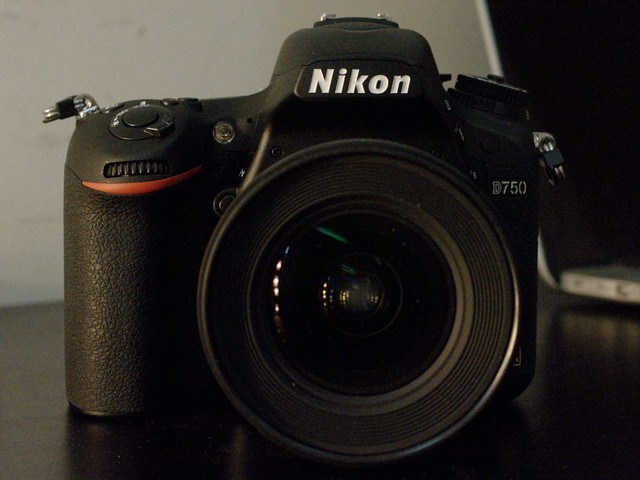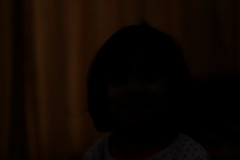A few days ago I got the opportunity to try out a Nikon D750, along with the new 20mm f/1.8G Nikkor lens. It wasn’t the best of times for trying out new toys for me, because of which I couldn’t get any presentable shots. I still got some shooting to do with it and I would go ahead to include those non-presentable shots anyway.
AF-S 20mm f/1.8G Nikkor
This is the first lens I have tried, that sports the Nano Crystal coating on it. I had very high expectations of this lens’s colour rendition due to the N coat and I am glad to say, I wasn’t the least bit disappointed. The photos from this lens have a nice and crisp feel to them where many other lenses, in comparison, would look “washed out”. Here’s a picture of me just out of bed, shot with a Nikon D7100:
The picture looks decently crisp. The colour rendition is somewhat similar to what I get from the Carl-Zeiss optic in an RX100, but of course, there’s a lot more tonal depth to it – it’s got the 3D-Look™. White-balance is deliberately under-corrected.
The lens is also able to focus surprisingly close – you can almost take it right up to the subject!

I have long been looking for a wide-angle prime lens for my DX body D7100, with 24mm being the desired focal length. Until now, Nikon only offered the super-expensive 24mm f/1.4G Nikkor and the dated and slow 24mm f/2.8D Nikkor. This lens, while being a bit wider, is significantly more affordable than the 24mm f/1.4G and significantly better than 24mm f/2.8D. Would I buy it? I’m not sure yet. It’s a bit heavier and bulkier than I imagined. Besides, given its performance on FX, it seems like a wasted opportunity to have it without a full-frame body. Which brings me to the D750.
D750 Image Quality
A lot has been written and said about D750’s image quality on the Internet and I am not going to add a lot more to it. I have previously done stupid things to be convinced that despite all the fanfare around small sensors these days, the full-frame advantage is undeniable. I am glad to report that my hands-on experience in this matter is as expected.
So what else is there to write about? Well, there’s Dynamic Range and ISO-less shooting.
The following, rather drab, dawn shot looks like a fairly easy to handle scene despite some impressive FoV coverage by the 20mm lens on D750 and nice sharpness and tonality.

In reality, though, this shot registered a -3EV under-exposure on the camera’s meter. All of the mid-tones and shadows you see here have been boosted in post-production with DxO Optics Pro 10. The result is that you can see the bluish hue of dawn light on the top-right corner of the orange wall progressively blend into the bright orange glow of the sodium-vapour lamp. Nearer still, you can make out the distinct greenish hue of the fluorescent tube illuminating the ground in front of the security booth while the rest of it is bluish from the dawn light.
Take my word for it – this is a scene I am intimately familiar with and never before have I seen it captured with such nuance as in the above photograph. This is a true example of what you can achieve with the immense dynamic range of the D750’s sensor. To those who say they don’t care about dynamic range, I have one word: idiocy. Oh, and take a look at what the capture looked like prior to all the shadow boosting:
ISO-less shooting is the technique that exploits the capability demonstrated above. If you look at the Dynamic Range curve for sensors like that of the D750, you would observe that they start with stellar DR at base ISO and lose about 1 stop DR for every stop of ISO increase. In theory, then, if you shoot at base ISO and under-expose by a couple of stops, you would get the same DR as a normally exposed shot at a couple of ISO stops higher. The benefit of shooting at base ISO is that you don’t blow highlights, unlike when you boost ISO. Of course, you can only use this technique if you are shooting 14-bit lossless RAWs and are using a good RAW converter.
I tried a shot with the D750 + 50mm f/1.8G at ISO 100, that I later boosted up by 4 EV. That shot turned out to be better than a normally exposed shot with D7100 + 20mm f/1.8G! On the left, below, is the uncorrected shot. On the right, the shot after +4 EV boost and in the middle, 100% crop of (slightly out-of-focus) hair detail.



D750 Handling
While I did really like the images coming out of the D750, I wasn’t that impressed with the body. One highly talked about feature of the body is its grip, which most reviewers have reported as being deeper and easier to grip. I didn’t really find it all that great. I still prefer the chunky grip on the D7100 that, along with back-button focusing, I can really squeeze on to and get greater shooting stability. As for carrying the camera during down-time, I think b-grip wins over a camera grip.
Another thing I didn’t like about the D750 was the view-finder – the AF confirmation blink, to be more specific. From the D3300 through D7100 to D750, the AF confirmation cues in the viewfinder get progressively more prominent. The D3xxx feels too subdued to me, while the D750’s was outright jarring in that it flashes the entire view-finder red, instead of just flashing the active focus point. I don’t want that… no way!
Coming, then, to the top LCD which has been slimmed down on the D750. Frankly, it’s pointless. It shows the shooting parameters alone, that I find more useful to look at through the view-finder. I don’t specifically remember what I was looking for in the LCD and missing, but it was frustrating to repeatedly not find it there.
One thing I did like about the D750 was the Live-View mode, which I switched into since neither the view-finder, nor the top LCD were to my liking. I must say, the LV mode on this camera is leaps and bounds better than on models like the D7100 or D3300. Aperture adjustment works. CDAF is fast enough to be usable, though not fast enough to match that of even relatively “slow” models like the RX100 or early NEX units. I like the fact that the LCD tilts, although I was surprised to find that it was more cumbersome to move than the one on my old NEX-5. It wasn’t as nice and bright as the one on D7100. Does it not have those white pixels?
D7100 vs D750
The final question is, would I like to replace my D7100 with the D750? While the improvements in IQ and shadow boosting capability along with Live-View improvements make me go, “oh yeah”, the overall “feel” of the camera is decidedly less pleasant than that of the D7100. I hated the AF confirmation blink in the view-finder. The tilting LCD needs to move better and look better. While ISO-less shooting sounds exciting, it is easier said than done because the preview in the LCD becomes too dark to be usable. All said and done, the answer is, “I’m not sure”.
Now, if only the Sony Alpha MILCs did lossless 14-bit RAW….